Complete Solutions to REVIEW QUESTIONS of chapter ABSORPTION BY ROOTS of Class 10 book with complete answers and questions
| Class 10 | BIOLOGY |
| Chapter | ABSORPTION BY ROOTS |
| EVERGREEN PUBLICATION | REVIEW QUESTIONS |
| Number Of Questions | 100 |
| Academic Year | 2023-24 |
Name the following :
A condition opposite to turgidity.
View SolutionName the following :
Dispersal of seeds by explosive mechanism.
View SolutionName the following :
Loss of cell sap through hydathodes from the tip or margin of leaf is due to root pressure.
View SolutionName the following :
The loss of water from injured parts of a plant.
View SolutionName the following
The tissue which conducts water in a plant.
View SolutionName the following :
The condition of a cell placed in hypotonic solution .
View SolutionName the following :
The process by wh ich root hairs absorb water from the soil.
View SolutionName the following :
The process by which molecules distribute themselves evenly within the space they occupy.
View SolutionGiven below are diagrams of plant cells as seen under the microscope after being placed in two different solutions :

Name the pressure responsible tor the movement of water from the root hair cell to the xylem of the root. How is it set-up?
View SolutionName the process by which water from plants is lost in liquid form
View SolutionThe movement of water molecules from a region of high concentration to a region of low concentration through a semipermeable membrane is due to
View SolutionName the following :
The process by wh ich root hairs absorb water from the soil.
View SolutionA solution containing lesser concentration than inside a cell.
View SolutionName the following :
The structure that transports water from the soil to other parts of the plant.
View SolutionExplain the movement of water cell to cell across the root: from the soil to the xylem.
View SolutionState whether the follow ing statements are true or false . Rewirte the false statements in their correct form:
A plant cell placed in hypotonic solution gets plasmolysed.
View SolutionState whether the following statements are true or false . Rewrtie the false statements in their correct form:
As compared to active transport, osmosis is a rapid process.
View SolutionState whether the follow ing statements are true or false . Rewirte the false statements in their correct form:
Diffusion is the reverse of osmosis .
View SolutionState whether the follow ing statements are true or false . Rewirte the false statements in their correct form:
Addition of salt to pickles prevents growth of bacteria because they turn turgid.
View SolutionState whether the follow ing statements are true or false . Rewirte the false statements in their correct form:
Upward movement of water and dissolved minerals in plants is called translocation .
View SolutionFill in the blanks :
Guttation in plants indicates .................... pressure .
View SolutionFill in the blanks :
Ascent of sap takes place through ..... ............. .
View SolutionFill in the blanks :
Shrinking of RBCs on keeping in hypertonic solution is called .....................
View SolutionFill in the blanks :
Leaves of a plant . .. . . . . . . . . . . . . . . . . . when its xylem vessels are blocked with wax.
View SolutionFill in the blanks :
................... takes place when two solutions of different concentrations are separated by a semi permeable membrane.
View SolutionFill in the blanks :
.............. takes place when two solutions of different concentrations are separated by a semi permeable membrane.
View SolutionFill in the blanks :
Wooden doors usually swell up during rainy season due to ……… .
View SolutionFill in the blanks :
The outward pressure exerted on the cell walls by the fluid contents of a fully turgid cell is called ………. .
View SolutionThe simple phenomenon of shrinkage of the protoplasm from the cell wall under the action of some strong solution ( than that of the cell sap ) is due to decrease in
View SolutionGive reasons :
A closed can containing dried seeds bursts open, if some water enters it accidentally.
View SolutionPickles have a long shelf life and do not get spoiled for months, Why ?
View SolutionGive reasons :
The roots of some plants are seen growing out through crevices in the walls.
View SolutionMany fresh water. animals can not survive in a marine environment. Explain.
View SolutionGive biological reason for the following statements :
Plants growing in fertilized soil are often found to wilt if the soil is not adequately watered.
View SolutionGive reasons :
Potato cubes when placed in water become firm and increase in size.
View SolutionGive reasons :
Plants begin to die when excess of soluble fertilizers are added to the soil.
View SolutionDifferentiate between :
Osmotic and Turgor pressure
View SolutionDifferentiate between :
Turgid and Flaccid cell
View SolutionDifferentiate between :
lmbibition and Osmosis
View SolutionDifferentiate between :
Diffusion and Osmosis
View SolutionDifferentiate between the following pairs on the basis of what is mentioned within the bracket.
Turgor pressure and wall pressure (Explain)
View SolutionExplain the term plasmolysis. Give one application of this phenomenon in our daily lives.
View SolutionComment upon the following :
Wooden doors and windows swell up during the rainy season .
View SolutionComment upon the following :
RBCs burst when kept in distilled water.
View SolutionComment upon the following :
When a plant cell is kept in hypertonic solution, it becomes flaccid.
View SolutionComment upon the following :
In ascent of sap, the sap moves upwards against the force of gravity.
View SolutionComment upon the following :
Large quantity of salts in pickles and sugar in jams and jellies is added .
View SolutionComment upon the following :
The leaves of Touch-me-not plant droop down on slight touching .
View SolutionComment upon the following :
Wilted lettuce becomes crisp/firm when placed in cold water for a while .
View SolutionDefine the following terms :
Diffusion
View SolutionDefine the following terms :
Osmosis
View SolutionDefine the following terms :
Turgor pressure
View SolutionDefine the following terms :
Active transport
View SolutionDefine the following terms :
Guttation
View SolutionDefine the following terms :
Osmotic pressure
View SolutionIn the given figures 'A' shows a cell in the normal state and 'B' shows the same cell after leaving it in a certain solution for a few minutes :

Describe the change which has occurred in the cell as seen in B.
View SolutionIn the given figures 'A' shows a cell in the normal state and 'B' shows the same cell after leaving it in a certain solution for a few minutes :

Give the technical terms for the condition of the cell as reached in B and as it was in A.
View SolutionIn the given figures 'A' shows a cell in the normal state and 'B' shows the same cell after leaving it in a certain solution for a few minutes :
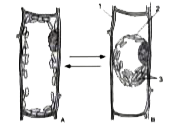
Define the process which led to this condition.
View SolutionIn the given figures 'A' shows a cell in the normal state and 'B' shows the same cell after leaving it in a certain solution for a few minutes :

Was the solution isotonic, hypotonic or hypertonic in which the cell was kept ?
View SolutionIn the given figures 'A' shows a cell in the normal state and 'B' shows the same cell after leaving it in a certain solution for a few minutes :
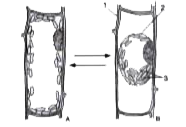
How can the cell in 'B', be brought back to its original condition ?
View SolutionIn the given figures 'A' shows a cell in the normal state and 'B' shows the same cell after leaving it in a certain solution for a few minutes :

Name the parts numbered 1 to 3 .
View SolutionThe figure given below represents the set-up at the start of certain experiment to demonstrate an activity of plants:

What is the aim of the experiment?
View SolutionThe figure given below represents the set-up at the start of certain experiment to demonstrate an activity of plants:

Why has oil been put in each test tube ?
View SolutionThe figure given below represents the set-up at the start of certain experiment to demonstrate an activity of plants:

What will be the observations in the two test tubes after about 2-3 days ?
View SolutionThe figure given below represents the set-up at the start of certain experiment to demonstrate an activity of plants:

Give reason to explain any change observed in test tubes after 2-3 days?
View SolutionThe figure given below represents the set-up at the start of certain experiment to demonstrate an activity of plants:

Why has the test tube 'B ', without the plant, been taken in the experiment?
View SolutionGiven below are the diagrams of a certain structure in plants in two conditions :

Name the structure shown.
View SolutionGiven below are the diagrams of a certain structure in plants in two conditions :

Name the parts numbered 1-5.
View SolutionGiven below are the diagrams of a certain structure in plants in two conditions :

What is the most apparent difference between A and B in the structure shown ?
View SolutionGiven below are the diagrams of a certain structure in plants in two conditions :

Describe the mechanism which brings about the change in the structures depicted in A and B.
View SolutionDescribe the mechanism which brings about the change in the structures depicted in A and B.

1. Cell wall
2 . Strong sugar solution
3 . Protoplasm
4 . Large vacuole
5. Nucleus
Study the diagram and answer the questions that follow:
What is the state of the cell shown in the diagram?
View SolutionDescribe the mechanism which brings about the change in the structures depicted in A and B.

1. Cell wall
2 . Strong sugar solution
3 . Protoplasm
4 . Large vacuole
5. Nucleus
Study the diagram and answer the questions that follow:
Name the structure which acts as a selectively permeable membrane.
View SolutionDescribe the mechanism which brings about the change in the structures depicted in A and B.

1. Cell wall
2 . Strong sugar solution
3 . Protoplasm
4 . Large vacuole
5. Nucleus
Study the diagram and answer the questions that follow:
What is the state of the cell shown in the diagram?
View SolutionDescribe the mechanism which brings about the change in the structures depicted in A and B.

1. Cell wall
2 . Strong sugar solution
3 . Protoplasm
4 . Large vacuole
5. Nucleus
Study the diagram and answer the questions that follow:
If the cell in the diagram possessed chloroplasts, where would these be present ?
View SolutionDescribe the mechanism which brings about the change in the structures depicted in A and B.

1. Cell wall
2 . Strong sugar solution
3 . Protoplasm
4 . Large vacuole
5. Nucleus
Study the diagram and answer the questions that follow:
Name any one feature of this plant cell which is not present in animal cells.
View SolutionThe diagram given below represents an experimental set-up to demonstrate a vital process. Study the same and then answer the questions that follow :

Name the process.
View SolutionThe diagram given below represents an experimental set-up to demonstrate a vital process. Study the same and then answer the questions that follow :

Name the process.
View SolutionThe diagram given below represents an experimental set-up to demonstrate a vital process. Study the same and then answer the questions that follow :

What would you observe in the experimental set-up after an hour or so ?
View SolutionThe diagram given below represents an experimental set-up to demonstrate a vital process. Study the same and then answer the questions that follow :

What control experiment can be set up for the above experiment ?
View SolutionThe diagram given below represents an experimental set-up to demonstrate a vital process. Study the same and then answer the questions that follow :

Keeping in mind the root hair cell and its surroundings, name the part that corresponds to (1) concentrated sugar solution
(2) parchment paper and
(3) water in the beaker.
View SolutionThe diagram given below represents an experimental set-up to demonstrate a vital process. Study the same and then answer the questions that follow :

Name any other substance that can be used instead of parchment paper in the above experiment.
View SolutionThe diagram given below represents an experimental set-up to demonstrate a vital process. Study the same and then answer the questions that follow :

Mention two advantages of this process to the plant.
View SolutionThe figure given below is a diagrammatic representation of a part of the cross-section of the root in the root hair zone. Study the same and then answer the questions that follow :
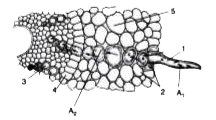
Name the parts indicated by guidelines '1' to '5'.
View SolutionThe figure given below is a diagrammatic representation of a part of the cross-section of the root in the root hair zone. Study the same and then answer the questions that follow :

Is the root hair cell unicellular or multicellular?
View SolutionThe figure given below is a diagrammatic representation of a part of the cross-section of the root in the root hair zone. Study the same and then answer the questions that follow :

Draw a labelled diagram of the root hair cell as it would appear if some fertilizer is added to the soil close to it.
View SolutionThe figure given below is a diagrammatic representation of a part of the cross-section of the root in the root hair zone. Study the same and then answer the questions that follow :

How is this pressure set-up ?
View SolutionThe figure given below is a diagrammatic representation of a part of the cross-section of the root in the root hair zone. Study the same and then answer the questions that follow :

What pressure is responsible for the movement of water in the direction indicated by arrows ?
View SolutionThe figure given below is a diagrammatic representation of a part of the cross-section of the root in the root hair zone. Study the same and then answer the questions that follow :

How is this pressure set-up ?
View SolutionGiven below is the diagram of an experiment just at the start. Study the diagram carefully and answer the following questions :

What phenomenon is intended to be shown by this experiment ?
View SolutionGiven below is the diagram of an experiment just at the start. Study the diagram carefully and answer the following questions :

Which limb of the U-tube contains more concentrated sucrose solution - A or B ?
View SolutionGiven below is the diagram of an experiment just at the start. Study the diagram carefully and answer the following questions :
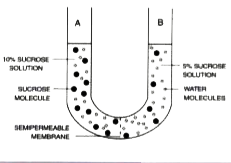
Why have the two kinds of molecules been shown in different sizes ?
View SolutionGiven below is the diagram of an experiment just at the start. Study the diagram carefully and answer the following questions :
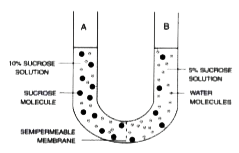
Why is the membrane separating the two solutions labelled as semipermeable membrane?
View SolutionGiven below is the diagram of an experiment just at the start. Study the diagram carefully and answer the following questions :
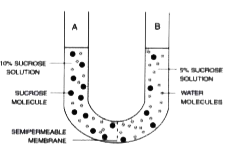
Which limb of the U tube (A or B) is functionally comparable to the root hairs of a plant ?
View SolutionGiven below is the diagram of an experiment just at the start. Study the diagram carefully and answer the following questions :
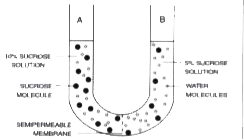
Redraw the diagram to show the result of the experiment after a few hours.
View SolutionRewrite the terms in correct order so as to be in a logical sequence :
Soil water, root hair, cells of cortex, epidermis, xylem.
View SolutionRewrite the terms in correct order so as to be in a logical sequence :
Soil water, root hair, cells of cortex, epidermis, xylem.
View SolutionExplain the following term :
Bleeding
View SolutionDefine the following terms :
Osmosis
View SolutionName the following :
A condition opposite to turgidity.
View SolutionExplain the following term :
Diffusion
View Solution
REVIEW QUESTIONS questions and complete solutions for chapter ABSORPTION BY ROOTS of EVERGREEN BIOLOGY (ENGLISH) of Class 10